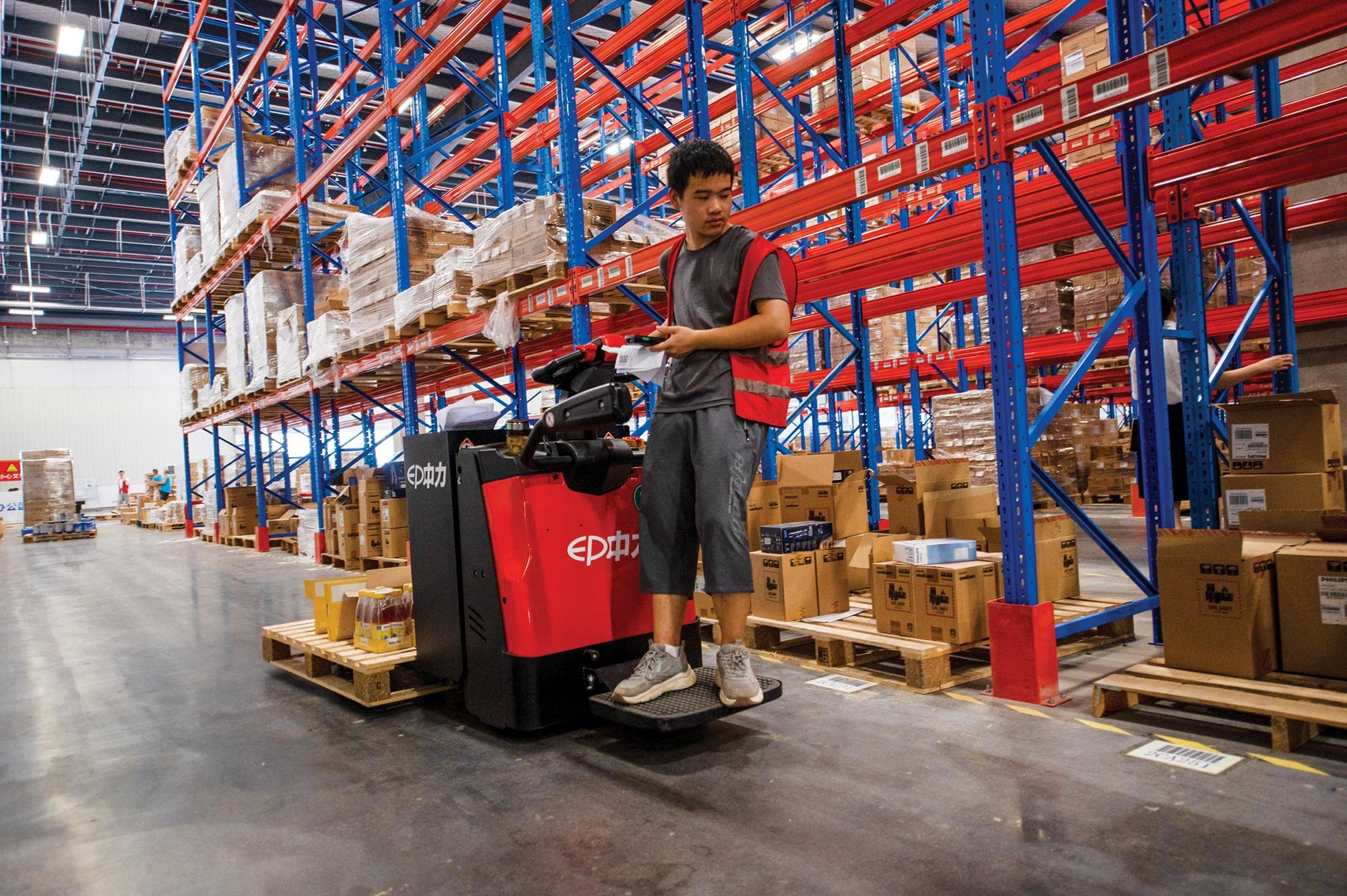Smaller entrepreneurs make big sales overseas by utilizing innovative online market places such as Temu and Shein
 (WU HEPING / FOR CHINA DAILY)
(WU HEPING / FOR CHINA DAILY)
The parents of Liu Wenhai, 33, who works in the foreign trade business in Yiwu, China’s small commodities hub in Zhejiang province, established a hat factory in his hometown in Shandong province about 10 years ago.
During the past three years, orders at the factory, which is located in Rizhao, have fallen by two-thirds due to the impact of the COVID-19 pandemic.
Liu said that when business was at its worst, hats produced at the factory had to be sold on domestic e-commerce platforms by the catty (a traditional measurement equivalent to 0.5 kilograms).
Looking to expand sales channels and reach more overseas consumers, Liu tried to sell hats through online retailers such as Alibaba Group’s AliExpress, Amazon, and eBay. However, only a small number were ordered, and he still faced high operational and logistical costs.
In October 2022, Liu received an invitation to register with Temu, a new cross-border e-commerce platform launched by Chinese online discounter PDD Holdings.
Unlike the traditional model that allows merchants to operate their own stores independently, Temu requires them to send their products to its domestic transit warehouses, while the platform is responsible for logistics, sales, operations, promotional activities, and after-sales services.
“I just had to give this a try,” Liu said. “To my surprise, inventory at our factory from about five or six years ago has all been cleared. I even transferred some orders to my uncle’s factory because of insufficient production capacity at my parents’ factory.
“We usually design and produce more than a dozen new products in line with the latest overseas fashion trends, before deciding whether to increase production based on sales in the online store.”
 Visitors tour an expo of goods traded at cross-border e-commerce platforms in Zhengzhou, Henan province, October 2023. (PROVIDED TO CHINA DAILY)
Visitors tour an expo of goods traded at cross-border e-commerce platforms in Zhengzhou, Henan province, October 2023. (PROVIDED TO CHINA DAILY)
Baseball caps have gained popularity among overseas shoppers, particularly in the United States, and more than 1 million hats prepared by Liu and his team sold out on Temu before the Black Friday shopping festival last November, he said.
Liu is among millions of young Chinese entrepreneurs whose parents run small or medium-sized factories that have survived operational difficulties by transforming themselves digitally.
Such operators are cashing in on the burgeoning cross-border e-commerce sector to secure new orders and boost their businesses. Experts said these cross-border online marketplaces have become an important new driving force for China’s foreign trade amid downward economic pressures and external uncertainties.
Launched in the US in September 2022, Temu offers a wide selection of merchandise — including clothing, electronic products, jewelry, shoes, handbags, cosmetics, and baby products — at competitive prices. It now has a presence in more than 40 countries in North America, Europe, Asia, and Oceania.
Industry insiders said Temu’s business model removes middlemen from the equation, allowing Chinese suppliers to sell directly to overseas consumers and ship directly from China, instead of building a network of warehouses abroad.
Chen Lei, chairman and co-CEO of PDD Holdings, said the company hopes to use the supply chain capacities it has built up in recent years to create a new channel. This outlet will enable consumers from different countries and regions to buy products directly from factories, providing more flexible and personalized supply chains, alongside more cost-effective shopping experiences.
Temu’s popularity among overseas shoppers has surged. Mobile app data analytics company Sensor Tower said Temu was downloaded more than 300 million times globally between September 2022 and November 2023.
 A worker sorts goods at a warehouse for cross-border e-commerce in Yiwu, Zhejiang province, August 2023. (PHOTO / XINHUA)
A worker sorts goods at a warehouse for cross-border e-commerce in Yiwu, Zhejiang province, August 2023. (PHOTO / XINHUA)
Data from research company Apptopia show that shoppers spend almost twice as long on Temu than on the apps of major rivals such as Amazon. On average, users spent 18 minutes a day on the Temu app in the second quarter of last year, compared with 10 minutes for Amazon and 11 minutes for AliExpress.
Li Mingtao, head of the research institute at the China International Electronic Commerce Center, said many Chinese foreign trade enterprises have gained an upper hand in production and quality control but lack experience and capabilities in sales and operation, making it difficult for them to enter overseas markets.
“As a new form of foreign trade, China’s fast-developing cross-border e-commerce platforms can help establish a direct and definitive connection between manufacturers and consumers by applying advanced digital technologies such as big data, cloud computing, and artificial intelligence,” he said.
Li added that manufacturers can better learn about and grasp the needs of consumers via these platforms, adjust production quickly, and reduce inventory, all of which will be conducive to improving the global competitiveness of Chinese manufacturing enterprises.
After obtaining a master’s in finance in New Zealand in 2018, Gong Zhihan decided to return to China to take over his family’s factory in Jinhua, Zhejiang province.
In 1999, Gong’s parents founded a company that manufactures microfiber products, including cleaning cloths, dishwashing mats, kitchen towels, and bath towels. The company was an original equipment manufacturer, or OEM, producing cleaning products for brands sold in US supermarkets and on Amazon.
OEM refers to when a company designs and markets a product but licenses it out to a manufacturer, such as Gong’s parents, to produce.
“Orders from traditional foreign trade have dropped by nearly 30 percent since 2020, as some industrial manufacturing chains have transferred to Southeast Asia and there has been weak demand from developed countries,” Gong said.
To improve the company’s profitability and optimize production capacity, Gong began selling products via cross-border e-commerce platforms such as Amazon and Walmart’s online marketplace.
 Goods traded at the cross-border e-commerce platform Temu prepare to board the airplane at Shanghai Pudong International Airport. (PROVIDED TO CHINA DAILY)
Goods traded at the cross-border e-commerce platform Temu prepare to board the airplane at Shanghai Pudong International Airport. (PROVIDED TO CHINA DAILY)
In November 2022, he registered with Temu.
“Temu can help me identify the needs of consumers more accurately, and I have become more sensitive about global market trends. Our sales on the platform surged as much as 40-fold between April and November,” Gong added.
His company makes customized designs based on the preferences of consumers in different countries and also obtains their feedback before launching new products. “We hope to build up self-owned brands on the platform to enhance users’ engagement and boost the repurchasing rate for products,” Gong said.
Other Chinese cross-border online marketplaces are accelerating their globalization push.
Fast-fashion retailer Shein announced a further expansion of its product categories by collaborating with selected global brands and third-party sellers to meet demand from consumers for a much wider variety of products and categories.
The company’s customers can now buy products other than fashionable attire, from home appliances such as portable washing machines to smart home products such as remote-controlled lighting.
Founded in Guangzhou, Guangdong province, and known for its low prices and large selection of fashionable clothing and accessories, Shein has gained traction among US shoppers. Data from the analysis platform App Intelligence showed that the number of Shein downloads in the US last November surged 26 percent year-on-year.
Meanwhile, last September, the short-video app TikTok, owned by Chinese technology company ByteDance, launched its TikTok Shop e-commerce service in the US. The service enables users to find and buy directly products used in livestreaming broadcasts and short videos.
TikTok, which began rolling out its e-commerce service in 2021 in Indonesia, has entered more than 10 countries, including the United Kingdom, Malaysia, Thailand, the Philippines, and Vietnam.
China’s cross-border e-commerce has seen robust growth in recent years, with the sector’s import and export scale reaching 2.38 trillion yuan ($332 billion) last year, up 15.6 percent year-on-year, the General Administration of Customs said.
“China’s cross-border e-commerce sector witnessed rapid growth during the pandemic to become an important driving force bolstering development of the nation’s foreign trade,” said Zhang Zhouping, a senior business-to-business and cross-border activities analyst at the Internet Economy Institute, a domestic consultancy.
Cross-border e-commerce is also playing a vital role in encouraging traditional foreign trade enterprises to build new brands and open up more overseas markets, Zhang added.
 Hosts sell goods to overseas customers during a livestreaming session at an expo held in Hangzhou, Zhejiang province, November 2023. (PHOTO / XINHUA)
Hosts sell goods to overseas customers during a livestreaming session at an expo held in Hangzhou, Zhejiang province, November 2023. (PHOTO / XINHUA)
Competition among cross-border e-commerce companies will focus on supply chain construction, he said, adding, “The core competitiveness of Temu and Shein lies in products with competitive prices and fast delivery, which are highly dependent on the establishment of the supply chain.”
However, experts have raised concerns about sustainability of the low-price strategy adopted by these platforms to attract bargain hunters, noting that it may squeeze the profit margins of small companies.
In view of the increasingly intensified competition among emerging Chinese cross-border e-commerce platforms targeting price-sensitive consumers, US tech company Amazon said it would sharply reduce fees for merchants selling clothing priced below $20.
Amazon recently reduced seller fees on clothing products priced below $15 to 5 percent, while the rates on clothing priced from $15 to $20 dropped to 10 percent. The fees for both categories had previously been 17 percent.
Cindy Tai, vice-president of Amazon and head of Amazon Global Selling Asia, said that this year the company will step up efforts to help Chinese merchants build brands, simplify global operations, and optimize global supply chain services. It will also support these merchants to expand their presence globally and to increase localization input.
Late last year, the company said it would launch its first innovation center in Shenzhen, Guangdong. The center is expected to accelerate innovation among sellers for new product introduction, brand building, digital operations, green development, and new business models.
Data from Amazon showed that the number of Chinese sellers with sales exceeding $1 million on the online retailer’s global sites rose by more than 25 percent year-on-year from October 2022 to September 2023. The number of such sellers with sales of more than $10 million rose by nearly 30 percent year-on-year.
Moreover, the quantity of merchandise sold by Chinese sellers to consumers and corporate buyers through Amazon’s global sites rose by more than 20 percent year-on-year in the same period.
“Cross-border e-commerce platforms connect some key links covering procurement, sales and logistics, to provide a new way for micro, small and medium-sized Chinese enterprises to expand their footprint abroad and create unprecedented new development opportunities,” said Zhang Jianping, head of the center for regional economic cooperation at the Chinese Academy of International Trade and Economic Cooperation.
These platforms are crucial in helping brands and manufacturers better grasp customer needs and quickly adjust product strategy and brand positioning, he added.
Cui Lili, director of Shanghai University of Finance and Economics’ Institute of E-commerce, said
Chinese enterprises should make full use of cross-border online platforms to meet demand from overseas markets promptly, learn more about laws, regulations, and quality standards in other countries, and adjust supply chains to make products that meet local requirements.


